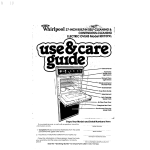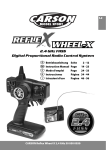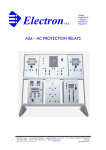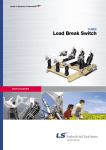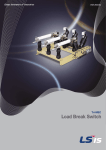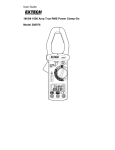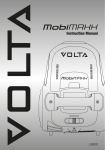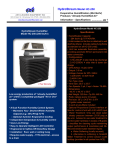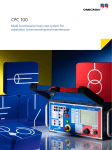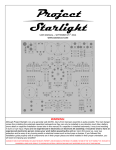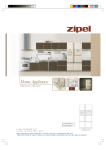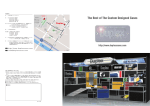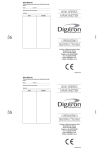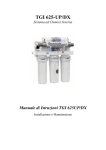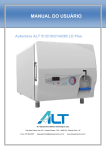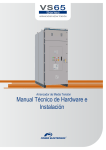Download LS Medium Voltage Vacuum Contactors - el
Transcript
Leader in Electrics & Automation Tri-MEC LS Medium Voltage Vacuum Contactors Electric Equipment Customer satisfaction through quality and serviceLS medium voltage vacuum contactors LS medium voltage vacuum contactors using LS vacuum interrupters manufactured with worldclass technology are type tested in LS PT & T that is accredited high power test lab by worldclass KOLAS. Contents Features 4 Electrical circuit diagram 20 Technical data 10 Internal connection diagrams 22 Ordering information 12 External dimensions 24 External view 14 Selection tables 28 Safety components 15 Power fuse 30 Internal structure 16 Power fuse selection guides 31 Vacuum interrupters 17 Coordination graph 32 Accessories 18 Operation curves 34 Drawing operations 19 LS Vacuum Contactors We have the major technology that others can not catch up. LS vacuum contactors provide high withstand-current strength and switching capacity as well as versatile auxiliary functions. Fixed type Drawout type (Standard type) General description LS Tri-MEC vacuum contactors are mainly used for the switching of motors, transformers, capacitors in AC power lines. They can be installed in multi-stack cubicles. A vacuum contactor comprises several assemblies such as switching mechanism including vacuum interrupters, magnetic actuator, high strength molded front cover and auxiliary devices. Stable and high operating cycle is executed by the vacuum interrupters made of high alumina ceramic tube which makes it possible to degas in a high temperature with excellent mechanical strength. Actuating is available either at instantaneous or continuous excitation. Functions for safety in connecting and disconnecting are also provided. 4 E-Class Cradle Direct-drawout type - for MCSG F2-Class Cradle Fuse connectable type (Standard type) G-Class Cradle Fuse connectable type (Direct-drawout type) Operation conditions Ambient temperature : -5 to 40℃ Maximum temperature of 24-hour mean : 35 ℃ Altitude : 1000m Humidity : 24-hour measured average - max. 95% RH 1 month measured average - max. 90% RH Applied standards IEC Pub. 60470, IEC 60282-1, JEM 1167, KEMC 1126 5 Up-graded performance Rated short-time current 6.3kA [ 6.3kA ] Performance is up-graded to rated short-time current 6.3kA/1sec. and switching capacity 4kA according to IEC60470. Short-circuit protection [ 40kA ] Power fused type vacuum contactors, in-house tested according to IEC 60282-1, can provide short-circuit protection up to 40kA. High performance, high reliability and long service life High speed interruption and short arcing time Reliable interruption of fault current LS vacuum interrupters that comply with IEC, ANSI and NEMA standards are manufactured by the process of brazing and degasing together in a high vacuum furnace to assure high reliability. It has fast recovering characteristic of vacuum insulation. When opening it breaks the current at the first current-zero point to minimize the wearing of contacts. the devices and systems from fault current LS current limiting power fuse can protect by interrupting within half cycle. High current such as short-circuit current cause a fuse blown out due to the reaction on the material inside of a fuse Superior mechanical strength and degasing within such a short time. Providing long service life and suited for frequently operating purpose due to using high alumina ceramic tube and degasing in a high temperature. Applied standards 6 IEC 282-1, DIN 43625, BS 2692, KSC 4612 Personnel safety [ Safety ] LS Tri-MEC vacuum contactors provide several auxiliary functions for safe and comfortable use. ■Interlock button ■Drawout cradle for MCSG ■One-molded fuse holder ■Fuse checher and micro switch Additional equipment ■Unification bushing ■Mechanical interlock type Suitable for Metal Clad Switchgear Interlock The structure of G type cradle unification equipped as standard. For the safety of a operator interlock is bushings and single-molded fuse-holder barrier enables vacuum contactors to Auxiliary contacts build Metal Clad Switchgears. Available up to 5NO+5NC. Directly withdrawable equipment This enables the withdrawing of a vacuum contactor from a panel without opening a door to prevent any possibility Contactor over contactor arrangement of electric shock. 7 Technical data Fixed (Z) type Type Rated operation voltage Rated voltage LVC-3Z -44�D LVC-6Z -44�D LVC-3D -42�D LVC-6D -42�D LVC-3D -44�D [kV] 3.3 6.6 3.3 6.6 3.3 6.6 3.3 Ur[kV] 3.6 7.2 3.6 7.2 3.6 7.2 3.6 le[A] Rated frequency fr[Hz] 200 400 200 3.3 7.2 3.6 7.2 400 E : Continuous 1200, L : Instantaneous 300 ×10,000operations] [× E : Continuous 300, L : Instantaneous 50 30 Impulse withstand Up[kVp] 60 Dielectric strength Ud[kV/1min] 20 Excitation method E : Continuous, L : Instantaneous Control voltage [V] Arrangement AC 110V, AC 220V, DC 110V Continuous 3a3b, Instantaneous 2a2b Current [A] Voltage [V] Motors [kW] 750 Transformers [kVA] 1,000 2,000 Capacitors [kVA] 750 1,500 Weight [kg] 2a2b 2a2b 10 (AC) 600max ~ 48min 1,500 1,500 3,000 750 2,000 4,000 1,200 2,000 24 Note) 고정형 상시조작형은 6a6b 가능 Power fuse Power fuses can be installed into combination(G, GB) type contactors for the protection of equipments and systems from short-circuit. Fuse ratings are selected properly after system analysis and some accessories such as fuse link clips should be selected by the fuse rating. 8 3.6 60 [op./hr] ×10,000operations] [× Max. Applicable 7.2 6.6 4 Mechanical Auxiliary contact 3.3 200 Electrical Lifetime 6.6 2.4kA-30s, 4kA-10s, 6kA-2s, 6.3kA-1s, 8kA-0.5s, 10kA-0.1s (kApeak- 0.5Cycle) Switching frequency(AC3) 6.6 50/60 (kA-sec) Rated short-time peak current LVC-6D LVC-3DB LVC-6DB LVC-3DB LVC-6DB -44�D -42�D -42�D -44�D -44�D 400 (kA, O-3min-CO-2min-CO) Rated short-time current Direct-drawout (DB) type - for MCSG LVC-6Z -42�D Rated operational current Rated breaking current Drawout (D) type LVC-3Z -42�D 1,500 1,500 1,000 2,000 750 1,500 41 3,000 750 1,500 1,500 2,000 4,000 1,000 2,000 2,000 4,000 1,200 2,000 750 1,500 1,200 2,000 56 3,000 Combination drawout (G) type Type LVC-6G -42�D LVC-3G -44�D LVC-6G -44�D LVC-3GB -42�D LVC-6GB -42�D LVC-3GB -44�D LVC-6GB -44�D [kV] 3.3 6.6 3.3 6.6 3.3 6.6 3.3 6.6 Ur[kV] 3.6 7.2 3.6 7.2 3.6 7.2 3.6 Rated operation voltage Rated voltage Rated operational current le[A] Rated frequency Combination direct-drawout (GB) type - for MCSG LVC-3G -42�D 200 400 200 fr[Hz] Rated breaking current PF Combination Rated breaking current 50/60 (kA, O-3min-CO-2min-CO) 4 kA (40kA with fuse) Making 40kA Breaking 40kA take over(O-3min-O-3min-O) Rated short-time current 4kA (kA-sec) Rated short-time peak current 2.4kA-30s, 4kA-10s, 6kA-2s, 6.3kA-1s, 8kA-0.5s, 10kA-0.1s (kApeak- 0.5Cycle) Switching frequency(AC3) 60 [op./hr] E : Continuous 1200, L : Instantaneous 300 Mechanical ×10,000operations] [× E : Continuous 300, L : Instantaneous 50 Electrical ×10,000operations] [× 30 Impulse withstand Up[kVp] 60 Dielectric strength Ud[kV/1min] Lifetime 7.2 400 20 Excitation method E : Continuous, L : Instantaneous Control voltage Auxiliary contact [V] AC 110V, AC 220V, DC 110V [A] 10 (AC) Arrangement 2a2b Current Voltage [V] Weight 600max ~ 48min [kg] 46 62 Note) 적용부하용량은 파워퓨즈의 정격에 따라 상이합니다. Power fuse ratings combination type Standard Rated voltage(kV) Rated current(A) LFL-3/6G-�B 3.6/7.2 5, 10, 20, 30, 40, 50, 63, 75, 100 LFL-3/6G-�B 3.6/7.2 Type DIN type LFL-3G-�B 3.6 160, 200 LFL-6G-�B 7.2 160, 200 LFL-3/6G-� 3.6/7.2 General use 125 Note1) LFL-3G-� 3.6 LFL-6G-� 7.2 LFL-3M-� 3.6 192 45 292 292 292 Application All application including transformers, motors and capacitors 50 75(T50), 100(T75) 60 311 General use 150(T100), 200(T150) 60 311 transformers 300(T250), 400(T300) 77 311 capacitors. 150(T100), 200(T150) 77 311 261 M20, M50, M100 60 200 M150, M200 77 200 M300(M400) Note2) 87 250 Motors M20, M50 60 311 capacitors. M100, M150 ,M200 77 350 87 450 For motors 7.2 (mm) 5(T1.5), 10(T3), 20(T7.5), 30(T15), 40(T20), 50(T30), 60(T30) KS type LFL-6M-� Diameter (mm) M300(M400) Note2) Note1) 퓨즈 정격전류가 100A를 초과시 퓨즈체커를 이용한 VC 연동을 금지합니다. Note2) M400적용시 자사와 협의 바랍니다. � LFL-6G-300, 400은 VC에 조합이 불가합니다. 9 Ordering information Contactor Control voltage(kV) Fuse checker PT Position Switch FUSE type D1 DC 110 0 Without 0 Without PT 0 Without 01 LFL-3/6G-5~60 L261-∅50 A1 AC 110 1 With 1 1EA of 100Var 1 With 02 LFL-3M-20~100 L200-∅60 LFL-3/6G-75~100 L311-∅60 A2 AC 220 2 2EA of 100Var 3 1EA of 200Var 4 2EA of 200Var 03 LFL-3G-150~200 04 LFL-3M-150~200 L200-∅77 LFL-3G-300~400 L311-∅77 LFL-6M-20~50 05 Contactor type LS Vacuum Contactor 10 Rated voltage(kV) Installation 3 3.6 Z Fixed type 6 7.2 D Drawout type G Combination drawout type (Fuse connectable) DB Direct-drawout type (For MCSG) GB Combination directdrawout type (Fuse connectable and for MCSG) Breaking current(kA) 4 4 Rated current(A) 2 200 4 400 LFL-6G-150~200 06 LFL-6M-100~200 L350-∅77 07 LFL-3M-300 L250-∅87 08 LFL-6M-300 L450-∅87 09 LFL-3/6G-5B~100B L258-∅45 10 LFL-3/6G-125B~200B L358-∅45 Control method E L Continuous excitation Instantaneous excitation Modification No. D Tri-MEC Conventional C type Cradle LS Cradle Rated voltage(kV) 3/6 3.6/ 7.2kV common Ratings Cradle Type Breaking current 42 / 44 E Position Switch E class PS1 1a1b PS2 2a2b 4kA F F2 class (with shutter only) Rated current G G class (with shutter and bushings) 200/400A common B For MCSG Mechanical interlock type LS Vacuum Contactor Mechanical Interlock Vacuum Contactor (VC1) Control voltage(V) DC 110V Vacuum Contactor (VC2) Control voltage(V) D1 D1 DC 110V 32E LVC-3Z-42ED A1 AC 110V 32E LVC-3Z-42ED A1 AC 110V 34E LVC-3Z-44ED A2 AC 220V 34E LVC-3Z-44ED A2 AC 220V 62E LVC-6Z-42ED 62E LVC-6Z-42ED 64E LVC-6Z-44ED 64E LVC-6Z-44ED 32L LVC-3Z-42LD 32L LVC-3Z-42LD 34L LVC-3Z-44LD 34L LVC-3Z-44LD 62L LVC-6Z-42LD 62L LVC-6Z-42LD 64L LVC-6Z-44LD 64L LVC-6Z-44LD 11 External view � � � � � � � � � � � � � Front cover � Fuse checking window � � Connector � � Unlock button(Interlock lever) � Handle(Draw-in and Drawout) � � ON/OFF indicator � Operation counter � � Manual trip button � Drawout carrier � � Direct drawout carrier � � Interlock lever � � Interlock button � Hole for Interlock lever insertion � � Test/Run indicator � � � Cradle � CTD(Condensor trip device) � � 12 � � Fuse case Safety components CTD(Condensor Trip Device) (For discharge) AC input CTD is built as standard in the contactor with AC control of instantaneous excitation so that the contactor can be tripped within 30 seconds in the event of an electricity failure. The automatic trip circuit in the event of an electricity failure is to be built by a customer. DC output Control circuit diagram Terminal Rating Description Type CTD-100 CTD-200 AC 100/110 AC 200/220 Rated input voltage(V) Frequency(Hz) 50/60 50/60 Rated impulse voltage(V) 140/155 280/310 Charging time Within 5 sec. Within 5 sec. Trip command possible time Max. 30 sec. Max. 30 sec. Input voltage range μF) Capacitor rating(μ 85%~110% 400 85%~110% 160 Dimensions Fuse case Counter Made of high strength BMC resin to offer This is a ON/OFF operation counter by superior insulation and safety. using 5 digit. Note) Applied fuse combination type. Bushing It is mono-block bushing to be used in the cradles of G-type drawout contactors. It provides high insulation level, so recommended to use in contactors for MCSG. Test/Run position indicator This enables checking contactor positions visibly when connecting or disconnecting a contactor. Note) Applied direct drawout type only. Note) Applied G-Class Cradle. Direct-drawout carrier ON/OFF indicator It is a screw-sliding type drawout To visiblly check whether power is equipment to draw-in and draw-out a supplied or not contactor directly out of a panel for personal safety. It is built in DB and GB type contactors. Lever Fuse checking window It is a bent-lever to actuate a direct- Enables the visible check of a fuse like its drawout carrier by inserting and turning outside status and temperature-rise in a in DB and GB type contactors fuse combination type contactor. 13 Internal structure Main contact part Consists of vacuum interrupters, main terminals and moving shunts that are supported by a one-moulded frame that maintains insulation between phases. Vacuum interrupters are operated by means of the actuating mechanism that is connected to movable parts of a vacuum interrupter with a insulation rod. Protection cover Line terminal Insulation mold frame Actuating mechanism Vacuum interrupter Load terminal Insulation rod Designed simply without any linkage to be suited for frequent-operation and long service life. The actuating lever connected to a moving core of a actuating magnet Shunt Contact spring Actuating lever Control coil Fixed core that carrys out the function of a actuating shaft moves up and down to control the Moving core Return spring contact pressure for stable operations. Spring guide Spring spacer Control method Main contact part Continuous excitation - During a contactor is closed the control coil is required to be excited continuously to pull the moving core magnetically. In case of discontinuing the control power the moving core is to be returned by a spring because of the disappearance of magnetic force, which causes the opening of a contactor. Instantaneous excitation - In this method the continuous exciting of a control coil to maintain the closing of a contactor is not required as the latch built in it holds the mechanism. In case of manual tripping, a contactor will be tripped by releasing the latch Latch mechanism when turn on the manual trip button. Continuous excitation Instantaneous excitation Control voltage Closing current(A)/ Trip current(A)/ Holding current(A)/ Pick-up Drop-out Tripping (V) time(ms) time(ms) time(ms) voltage voltage voltage DC 110 3/100 - 0.6/40 AC 110 3/100 - 0.6/40 85% 75% - 2/100 - 0.3/40 4.5/145 3/35 - 4.5(6)/145 3(4)/35 - 85% 75% 10%~75% 3(4)/145 10(14)/35 - Type Control method �LVC-3/6� Continuous excitation(E) AC 220 Instantaneous excitation(L) DC 110 Instantaneous excitation(L) (With CTD) AC 110 AC 220 42/44ED �LVC-3/6� 42/44LD Note) The values in ( ) are maximum allowable currents in case of using CTD. (voltage increment considered) 14 Vacuum interrupters Features Vacuum interrupters In the closed position, normal current flows Moving electrode through the interrupter. When a fault occur Moving electrode terminal and interruption is required, the contacts are quickly separated. The are which is oriented Bellows between surfaces of contact shall diffuse at Bellows shield the contact structure of flat shape. It prevents Ceramic local heating and damage. The arc burns in Arc shield an ionized metal vapor, which condenses on the surrounding metal shield. Contact Fixed electrode terminal The arc is extinguished and vapor production Fixed electrode is ceased at current zero. The metal vapor External view Internal structure plasma is very rapidly dispersed, cooled, recombined, and deionized, and the metal LS vacuum interrupters consists of spiral contact, vapor products are quickly condensed so that the material of which is CuCr to provide a long service life and the contacts withstand the transient recovery high withstand voltage characteristic. voltage. Ratings Fixed electrode Rated voltage (kV) 7.2 Rated current (A) 400 (kA) 4.5 Contact stroke (mm) 4.75 Opening speed average (m/s) 0.6 Closing speed average (m/s) 0.3 Contact force (kg) 7 Min Moving side weight (kg) 0.23 (kg) 0.52 (mm) 1 Rated interrupting current Interrupter weight Max. contact erosion Dimensions (i) Weld (ii) Bridge explosion Arc initiation Fault current (i) Contact jets (ii) Shield involvement High current arc mode (i) Arc instability (ii) Interruption Current zero Time (㎲) Time (ms) Voltage phenomena (i) Arc re-ignition (ii)Restrikes (iii) B.I.L (iv) A.C.voltage withstand Recovery voltage AC arcing and interruption phenomena in vacuum 15 Accessories Fuse checker / Micro switch Fuse checker is operated in case of fuse blowing and output mechanical signal at same time. A micro switch is a part of fuse checker. The mechanical input signal is changed to electrical out signal by micro switch. Note) 19-20 : NO contact, 19-21 : NC contact Fuse checker / Micro switch PT(Potential transformer) 2 each of PTs can be mounted on drawout type contactors and fuse combination type. These are 100VA and 200VA PTs rated 3.6/7.2kV. Rated voltage(V) Secondary voltage(V) Class Burden(Var) Frequency(Hz) 3300/6600 110/220 1 100/200 50/60 PT(Potential transformer) Fuse clip It is used to install or uninstall a fuse link to the holder. Its dimensions depend on ratings. Note) Refer to fuse selection table on page 11. Fuse clip Auxiliary switch Auxiliary switches are 2NO+2NC as standard and additional 3NO+3NC can be added on request. Auxiliary switch Position switch This enables checking contactor positions when draw-in and draw-out. Remote checking is also possible through signaling via micro switches in each position. 16 Drawing operations For standard draw-out types (D, G) ■ When draw-in a contactor into a cradle. <TEST Position> Cradle 1. Check that the contactor is in the state of open (TEST Position). 2. While pushing the unlock push button, insert the contactor about 50mm into the cradle. 3. Release the unlock push button and push the contactor into the cradle by the Unlock button Interlock plate RUN position. Unlock pin ■ When draw-out a contactor from a cradle. 1. Check that the contactor is in the state of open (RUN Position). 2. While pushing the unlock push button, draw the contactor about 50mm out of <RUN Position> the cradle. Cradle 3. Release the unlock push button and pull the contactor from the cradle by the TEST position. Unlock button Unlock plate Unlock 108mm(Stroke) Unlock Unlock pin Details of TEST/RUN Position For direct draw-out types (DB, GB) <TEST Position> Cradle ■ When draw-in a contactor into a cradle. 1. Check that the contactor is in the state of open (TEST Position). 2. While pushing the both sides of Interlock handle to the direction of the arrows, insert the contactor about 50mm into the cradle. 3. Insert the drawout lever into a hole as shown in the fig. While pushing the Interlock push button, swing the lever clockwise two times and release the Interlock push button. Interlock lever Interlock button A hole for a drawout lever 4. Turning the lever clockwise until the contactor reaches in the RUN position. ■ When draw-out a contactor from a cradle. <RUN Position> Cradle 1. Check that the contactor is in the state of open (RUN Position). 2. Insert the drawout lever into a hole as shown in the fig. While pushing the Interlock push button, swing the lever counterclockwise two times and release Interlock lever the Interlock push button. 4. Turning the lever counterclockwise until the contactor reaches in the TEST position. Interlock button A hole for a drawout lever 5. In case of separating the contactor from the cradle pull the contactor while pushing the both sides of Interlock handle to the direction of the arrows as shown in the fig. Note) Check the power before connecting or disconnecting. 17 Electrical circuit diagram Fixed type (Continuous excitation) Continuous excitation DC control �Impress the power to terminal No.1 and 2. �ON/OFF operating by using contacts of terminal No.3 and 4. Note) ----- : User's wiring part AC control �Impress the power to terminal No.1 and 2. �ON/OFF operating by using contacts of terminal No.3 and 4. Note) ----- : User's wiring part 18 Fixed type (Instantaneous excitation) Instantaneous excitation DC control �Impress the power to terminal No.1 and 2. �Input : ON/OFF operating by using No.4 terminal �Output : Trip by using No.5 terminal Note) ----- : User's wiring part AC control(CTD equipped) �Impress the power to terminal No.1 and 2. �Input : ON/OFF operating by using No.4 terminal �Output : Trip by using No.5 terminal Note) ----- : User's wiring part 19 Internal connection diagrams Drawout type (Continuous excitation) Continuous excitation DC control �Impress the power to terminal No.1 and 2. �ON/OFF operating by using contacts of terminal No.3 and 4. Note) ----- : User's wiring part AC control �Impress the power to terminal No.1 and 2. �ON/OFF operating by using contacts of terminal No.3 and 4. Note) ----- : User's wiring part 20 Drawout type (Instantaneous excitation) Instantaneous excitation DC control �Impress the power to terminal No.1 and 2. �Input : ON/OFF operating by using No.4 terminal �Output : Trip by using No.5 terminal Note) ----- : User's wiring part AC control(CTD equipped) �Impress the power to terminal No.1 and 2. �Input : ON/OFF operating by using No.4 terminal �Output : Trip by using No.5 terminal Note) ----- : User's wiring part 21 Connection diagrams Mechanical interlock type (Instantaneous excitation) Instantaneous excitation DC VC1 A 13 A2 B 43 x 14 A CC AC 1 12 2 13 14 4 5 44 7 8 9 10 11 x Relay TC 7 11 15 14 9 13 11 27 26 25 24 23 22 21 17 16 15 14 13 12 11 8 12 5 24 10 14 4 AUX S/W 1 <2a2b> VC2 A 13 B 43 x 14 A AC A2 1 12 2 13 14 4 5 CC 44 7 8 9 10 11 x Relay TC 7 11 15 14 9 13 11 <2a2b> 27 26 25 24 23 22 21 17 16 15 14 13 12 11 8 12 5 24 10 14 4 AUX S/W 2 AC (With CTD) VC1 13 A - Z + 44 CC 11 15 14 9 13 11 <2a2b> 14 15 C1 A 7 13 3 5 x Relay TC 12 2 4 14 ~ B 43 x ~ AC A2 1 27 26 25 24 23 22 21 17 16 15 14 13 12 11 8 12 5 24 10 14 4 C3 C5 C6 4 5 6 7 1 2 3 8 9 7 8 9 10 11 12 CTD 10 11 AUX S/W 1 VC2 13 - Z ~ B CC <2a2b> A2 43 x ~ AC 22 A + 14 44 17 16 15 14 13 12 11 13 3 14 15 5 x Relay 7 11 15 14 9 13 11 12 2 4 C1 A TC 1 27 26 25 24 23 22 21 AUX S/W 2 8 12 5 24 10 14 4 C3 C5 C6 4 5 6 7 1 2 3 8 7 8 9 10 11 12 9 10 11 CTD Mechanical interlock type (Continuous excitation) Continuous excitation DC 1 3 1 12 2 13 3 14 4 15 5 16 VC1 4 ON OFF (+) Vzb1 R Vzb2 DC CC CC 2 1 2 3 4 5 6 12 13 14 15 16 B A 11 10 12 6 A 6 9 B 5 11 15 14 9 13 11 CC 13 15 14 10 11 A A CC 9 5 R22 R2 CC B (-) R21 R12 R B CC 9 10 11 R11 16 27 17 16 15 14 13 12 11 26 25 24 23 22 21 6 12 16 24 10 14 AUX S/W 1 <3a2b> 1 12 2 13 3 14 4 15 5 16 VC2 1 3 4 R11 ON OFF (+) Vzb2 R Vzb1 DC CC CC 2 1 2 3 4 5 6 12 13 14 15 16 B B A 6 11 13 10 12 14 9 B A 10 11 A CC 9 5 6 CC B (-) R22 R2 A CC 9 10 11 R21 R12 R 5 11 15 14 9 13 11 CC 15 16 27 17 16 15 14 13 12 11 26 25 24 23 22 21 6 12 16 24 10 14 AUX S/W 2 <3a2b> AC 1 VC1 4 3 ON OFF Vzb1 R Vzb2 AC 1 2 3 4 5 6 12 13 14 15 16 B A CC CC 2 B 11 9 6 10 12 12 13 14 15 16 CC A A 5 11 15 14 9 13 11 CC 13 15 ~ + 14 R22 R B CC 5 R12 R A CC 9 10 11 R2 R1 B 1 2 3 4 5 6 Z - 27 6 26 12 25 16 24 24 23 10 22 14 21 9 10 11 AUX S/W ~ 16 17 16 15 14 13 12 11 <3a2b> VC2 1 1 2 3 4 5 6 4 3 ON OFF Vzb2 R Vzb1 AC 1 2 3 4 5 6 12 13 14 15 16 B A CC B CC 2 5 9 11 CC 9 10 11 R12 R A B A CC A 5 11 15 14 9 13 11 CC 13 15 ~ Z ~ 10 12 R22 R CC + 6 R2 R1 B 12 13 14 15 16 - 17 16 15 14 13 12 11 27 26 25 24 23 22 21 6 12 16 24 10 14 9 10 11 AUX S/W 14 16 <3a2b> 23 External dimensions Fixed type 〔Unit : mm〕 〕 LVC-3/6Z-42/44E(L)D (Terminal hole) Mounting hole Drawout type w/o a cradle LVC-3/6D-42/44E(L)D Combination drawout type w/o a cradle (Fused combination) LVC-3/6G-42/44E(L)D 24 (Terminal hole) Mounting hole Drawout type 〔Unit : mm〕 〕 E-Class Cradle (Terminal hole) (Terminal hole) Mounting hole Mounting hole F2-Class Cradle (Terminal hole) (Terminal hole) Mounting hole Mounting hole G-Class Cradle (Terminal hole) (Terminal hole) Mounting hole Mounting hole 25 External dimensions Combination drawout type 〔Unit : mm〕 〕 (Fused combination) E-Class Cradle (Terminal hole) (Terminal hole) Mounting hole Mounting hole F2-Class Cradle (Terminal hole) (Terminal hole) Mounting hole Mounting hole G-Class Cradle (Terminal hole) (Terminal hole) 26 Mounting hole Mounting hole Direct-drawout type 〔Unit : mm〕 〕 (For MCSG) B-Class Cradle (Terminal hole) (Terminal hole) Mounting hole Mounting hole Mechanical Interlock type 27 17 26 16 25 24 15 14 23 13 22 12 21 11 27 17 ON 26 25 16 15 24 14 23 13 22 12 21 11 27 Selection tables Fuse selection by load Fuse link Application Rated Lowest Rated Rated interrupting interrupting voltage current current current DIN type Model LFL LFL LFL LFL LFL LFL LFL LFL LFL LFL LFL LFL LFL LFL LFL LFL LFL LFL LFL LFL LFL LFL LFL LFL LFL LFL (kV) - 3/6G - 5B - 3/6G - 10B - 3/6G - 20B - 3/6G - 30B - 3/6G - 40B - 3/6G - 50B - 3/6G - 60B - 3/6G - 75B - 3/6G - 100B - 3/6G - 125B - 3G - 160B - 3G - 200B - 6G - 160B - 6G - 200B - 20G - 5B - 20G - 10B - 20G - 20B - 20G - 30B - 20G - 40B - 20G - 50B - 20G - 60B - 20G - 75C - 20G - 100C - 20G - 125B - 20G - 160B - 20G - 200B 3.6 (7.2) 3.6 7.2 24 (kA) (A) 5 10 20 30 40 50 63 75 100 125 160 200 160 200 5 10 20 30 40 50 60 75 100 125 160 200 (A) 4In 40 5In 25 Capacitive load(kVA) Transformer load(kVA) Single phase 4 6 15 21 40 49 66 68 128 151 211 265 ~ 8 ~ 13 ~ 31 ~ 42 ~ 82 ~ 102 ~ 137 ~ 165 ~ 220 ~ 275 ~ 352 ~ 440 20 43 99 149 267 345 430 580 923 1,364 2,125 2,650 ※( 8 ~ ( 13 ~ ( 30 ~ ( 40 ~ ( 80 ~ ( 98 ~ (132 ~ (134 ~ (256 ~ (302 ~ ( ( (425 ~ (437 ~ ~ 43 ~ 90 ~ 206 ~ 310 ~ 557 ~ 719 ~ 897 ~ 1,145 ~ 1,527 ~ 1,908 ~ 2,443 ~ 3,050 Three phase 6.7 11 25 35 69 85 114 117 222 261 365 495 16 ) 25 ) 62 ) 84 ) 165) 204) 275) 330) 440) 550) ) ) 704) 880) ~ 14 ~ 22 ~ 53 ~ 73 ~ 143 ~ 117 ~ 238 ~ 285 ~ 381 ~ 476 ~ 610 ~ 762 36 75 172 258 464 598 745 1,000 1,600 2,362 3,680 4,593 ※( 13 ~ 28 ) ( 21 ~ 44 ) ( 51 ~ 107 ) ( 70 ~ 145 ) (137 ~ 286) (170 ~ 354 ) (229 ~ 476 ) (233 ~ 571 ) (443 ~ 762 ) (522 ~ 952 ) ( ) ( ) (735~1,220 ) ※ (755~1,520 ) ~ 75 ~ 157 ~ 358 ~ 538 ~ 965 ~ 1,246 ~ 1,554 ~ 1,983 ~ 2,645 ~ 3,304 ~ 4,232 ~ 5,287 Three phase 9.8up to ※( 9.8up to ) 9.8 ~ 12 ( 19 ~ 24 ) 12 ~ 31 ( 24 ~ 61 ) 31 ~ 46 ( 61 ~ 92 ) 46 ~ 64 ( 92 ~ 128) 64 ~ 81 (128 ~ 163 ) 181 ~ 105 (163 ~ 210 ) 105 ~ 150 (210 ~ 300 ) 150 ~ 222 (300 ~ 445 ) 222 ~ 275 (445 ~ 550 ) 275 ~ 370 ( ) 370 ~ 550 ( ) (550~742 ) (742~1,000 ) 46up to 46 ~ 83 83 ~ 203 203 ~ 317 317 ~ 425 425 ~ 564 564 ~ 710 710 ~ 1,021 1,021 ~ 1,655 1,655 ~ 2,370 2,370 ~ 3,170 3,170 ~ 4,000 Fuse selection by load Fuse link Application Rated Lowest Rated Rated interrupting interrupting voltage current current current KS type Model G(General use) type M(Motor protection) type 28 LFL LFL LFL LFL LFL LFL LFL LFL LFL LFL LFL LFL LFL LFL LFL LFL LFL LFL LFL LFL LFL LFL LFL LFL LFL LFL LFL LFL LFL LFL LFL - 3/6G - 3/6G - 3/6G - 3/6G - 3/6G - 3/6G - 3/6G - 3/6G - 3/6G - 3G - 3G - 3G - 3G - 6G - 6G - 6G - 6G - 3M - 3M - 3M - 3M - 3M - 3M - 3M - 6M - 6M - 6M - 6M - 6M - 6M - 6M (kV) - 5 - 10 - 20 - 30 - 40 - 50 - 60 - 75 - 100 - 150 - 200 - 300 - 400 - 150 - 200 - 300 - 400 - 20 - 50 - 100 - 150 - 200 - 300 - 400 - 20 - 50 - 100 - 150 - 200 - 300 - 400 3.6 (7.2) 3.6 7.2 3.6 7.2 (A) 5 10 20 30 40 50 63 75 100 150 200 300 400 150 200 300 400 20 50 100 150 200 300 400 20 50 100 150 200 300 400 (kA) 40 40 (A) 5In 7In Transformer load(kVA) Single phase ※ ( 5up to ) 10up to ( 15up to ) 20up to ( 50up to ) 30up to ( 75up to ) 50up to ( 100up to ) 75up to ( 150up to ) ( ) 150up to ( 200up to ) 200up to ( 400up to ) 300up to ( ) 400up to ( ) 625up to ( ) 750up to ( ) ( 500up to ) ( 750up to ) (1,250up to) ( ) - Capacitive load(kVA) Three phase Three phase 5up to ※( 15up to ) 15up to ( 30up to ) 30up to ( 75up to ) 75up to ( 150up to ) 100up to ( 200up to ) 150up to ( 300up to ) ( ) 200up to ( 400up to ) 375up to ( 750up to ) 500up to ( ) 750up to ( ) 1,000up to ( ) 1,500up to ( ) (1,000up to) (1,500up to) (2,000up to) (2,500up to) ※( ) 10up to ( 25up to ) 30up to ( 50up to ) 50up to ( 100up to ) 75up to ( 150up to ) 100up to ( 200up to ) ( ) 200up to ( 400up to ) 300up to ( 600up to ) 400up to ( ) 600up to ( ) 1,000up to ( ) ( ) ( 800up to ) (1,200up to) ( ) ( ) 50up to ※( ) 150up to ( ) 300up to ( ) 400up to ( ) 800up to ( ) 1,000up to ( ) ( ) ( 100up to ) ( 300up to ) ( 600up to ) ( 800up to ) ( ) ( ) ( ) Fuse selection by load Selecting conditions and warning Dimensions(mm) Applicable holder Motor load(kVA) A B C D ) apply to the loads of 7.2kV. 2. It is assumed that the inrush current of a transformer is Three phase 6.5 ~10.7 ※( 13 ~ 22 ) 10.7 ~ 28 ( 22 ~ 36 ) 28 ~ 57 ( 36 ~ 86 ) 50 ~ 85 ( 86 ~ 117 ) 85 ~ 115 (117 ~ 230) 115 ~ 142 (230 ~ 284 ) 138 ~ 191 (276 ~ 382 ) 181 ~ 252 (362 ~ 503 ) 253 ~ 369 (469 ~ 739 ) 293 ~ 435 (556 ~ 870 ) 343 ~ 572 ( ) 375 ~ 630 ( ) (751~1,223 ) (1,154~1,760 ) - 1. ※ The values in ( 10 times of the full load current of a motor for 0.1 second. 195 55 - - The rated current of a fuse is selected to carry LFH-6G-D1HB continuously the current of 1.5 times of rated current of a transformer.(1.3 times in the case of ※) - In the transformer load table it is assumed that the 192 77 - - interruption will be made at 25 times of rated current within 2 seconds. 292 77 - - LFH-6G-D2HB 3. It is assumed that the inrush current of a motor is 5 times of full load current for 10 seconds. 4. In the case of using the M(motor protection) type 442 55 - fuses for the purpose of the short-circuit protection of - a motor or a starter select the proper rating in addition refer to the characteristic curves on the 442 77 - LFH-20G-D2HB catalog to make the device protected from overload by a circuit breaker or a contactor. 5. It is assumed that the inrush current of a capacitor is 442 87 - - 71 times of its rated current for 0.002 second. - The rated current of a fuse is selected to carry continuously the current of 1.43 times of rated current of a capacitor. Fuse selection by load - In case service life of more than 1000 operations is Dimensions(mm) required select in the M( motor protection) type fuse Applicable holder Motor load(kW) A B C D 6. The above mentioned comments are according to Three phase 37 ~ 75 90 ~ 200 220 ~ 400 450 ~ 630 710 ~ 800 900 ~1250 1,500 - ) ※( ( ) ( ) ( ) ( ) ( ) ( ) ( 75 ~ 160 ) (185 ~ 400 ) (450 ~ 800 ) (900 ~ 1,250) ( 1,500 ) ( 2,500 ) ( 3,000 ) table. KS(Korean Industrial Standard) and subject to the real situation. 261 50 47 25 LFH-6G-D60 311 60 57 30 LFH-6G-D1H 311 77 73 43 LFH-6G-D2H 350 110 108 55 LFH-6G-D4H 200 60 58 30 LFH-3M-100 200 77 73 43 LFH-3M-200 250 87 84 50 LFH-3M-400 311 60 58 30 LFH-6M-50 350 77 73 43 LFH-6M-200 450 87 84 50 LFH-6M-400 DIN-Type fuse 29 Power fuse Power fuse LS Prime-MEC power fuses are designed to protect equipments from fault current such as short-circuit, and generally used for the protection the circuits of transformers, capacitors and motors they protect. For further safety and reliability the elements inside of fuses are made of silver, and high quality quartzs and and ceramic are used for magnetic rods and tubes, respectively. LS medium voltage vacuum contactors using LS vacuum interrupters manufactured with worldclass technology are type tested in LS PT & T that is accredited high power test lab by worldclass KOLAS. To ensure the performance they, installed in a vacuum contactor, are tested according to IEC 60282-1 in LS PT & T that is accredited high power test lab by worldclass KOLAS. KERI(24kV) Considerations in application �Power fuses are suitable for the protection from a short-circuit, Overload current will not protected. �Reset or re-use after blowing is not possible. Fuse reset or re-use is not possible after fused are blown out. �When the fuses are selected, the inrush currents arising from the starting transformers, motors, capacitors should be considered. �When the fuses are selected, their usage and circuit requirements should be considered. �For the purpose of protection from the fault current below the lowest interrupting current of the fuse it is desirable to replace it with a fuse having lower interrupting rate or add other overcurrent relay in series �Withstand voltage of the circuit should be higher than that of a fuse that protects it. �If possible, select the fuse whose rated current is much higher than the load current. The rated current not sufficiently exceeding the normal current of the load may cause reduction in the service life. �Replace all three fuses in case of blowing in a fuse. Determination of the rated current The rated current of the fuse must be selected properly after examination of the current/time characteristics of fuses, equipments and the related circuit conditions. General considerations �When the fuses are selected the sufficient rated current should be considered to avoid the deterioration of the fuse element due to sustained load current in the long term. �The fuse rated current should be higher than the sum of all load currents. �The estimated overload current should be within the fuse's time/current characteristics.The estimated overload current should not exceed the allowable overload withstand currents of the equipment and the number of its events should not exceed 100 times. �The characteristic curve of a fuse must lie to the right of those of other equipments to be protected. �The withstand strength such as permissible let-through current, I² t of the equipments to be protected must be higher than that of a fuse. �Coordination of permissible time limit Protection equipments in the line side < Fuses < Protection equipments in the load side �Coordination when fuses are used as back-up protection Permissible let-through current of a fuse < That of a protection equipment �Use the same rating for all three phases even the differential current between phases exists. 30 Power fuse selection guides Considerations by the type of load 1. Power fuses for transformer loads �The fuse with sufficient rated current must be selected to avoid the deterioration of the fuse element due to permissible overload in the long term. �The fuse's current/time characteristic should cover the inrush current/time of the transformer. �In case of power transformers the symmetrical inrush current must be within 10 times of the fuse rating and the fuse should withstand at least 0.1second under the condition. �Fuse rated current ≥ Transformer rated current �The lowest interrupting current of the fuse < Short circuit current in the primary of the fuse �In case of protection of two or more transformers - Fuse rating should be selected on the basis of the phase condition where maximum current flows. - In the event of short-circuit in the secondary of the transformer The lowest interrupting current of the fuse < Short circuit current in the primary of the transformer �In case of potential transformers Power fuses for transformer loads - When the fuses are selected do not consider the short-circuit happening in the secondary of the PT, but protecting PT itself and the circuit against the fault in the primary side. - Select the fuse with higher rated current than the load current so as not to be damaged by overcurrent. - The characteristic curve of a fuse must lie to the right of those of other equipments to be protected. - The withstand strength such as permissible let-through current, I² t of the equipments to be protected must be higher than that of a fuse. Note) Refer to the general considerations other than the above mentioned. 2. Power fuses for motor loads �The fuse with sufficient rated current must be selected to avoid the deterioration of the - fuse element due to permissible overload in the long term. �The fuse's current/time characteristic should cover the inrush current/time of the motor. - The inrush current of the motor must be within 5 times of the fuse rating and the fuse Power fuses for motor loads should withstand at least 10 seconds under the condition. Fuse rated current ≥ Motor full load current Note) Refer to the general considerations other than the above mentioned. 3. Power fuses for combination with vacuum contactors �The current at the intersection between a fuse characteristic curve and a contactor Note) Above picture shows korean standard type, If you want to order DIN type fuse, please contact LS Industrial Systems before you order it. operation curve should greater than the lowest interrupting current of a fuse. �And the current at the cross point between a fuse curve and a contactor minimum dropout curve should not greater than the rated interrupting current of a contactor. Note) Refer to the general considerations other than the above mentioned. 4. Power fuses for capacitor loads �The fuse with sufficient rated current must be selected to avoid the deterioration of the fuse element due to permissible overload in the long term. �The fuse's current/time characteristic should cover the inrush current/time of the capacitor. �The size of inrush current depends on whether or not the serial reactors and parallel capacitors exist. �The inrush current of the capacitor must be within 70 times of the fuse rating and the fuse should withstand at least 0.002 second under the condition. Fuse rated current ≥ Capacitor rated current �In the case of serial reactor(6%) connected the inrush current must be within 5 times of the fuse rating and the fuse should withstand at least 0.1 second under the condition Note) Refer to the general considerations other than the above mentioned. 31 Coordination graph Coordination between fuse and transformer circuit [5] [4] [3] [6] Fuse [2] [1] Characteristic curve of a secondary circuit breaker or low voltage fuse (Converted into the primary values) Permissible overload characteristic curve of a transformer Time/Current characteristic curve of a Fuse Blow-out characteristic curve of a Fuse Transformer Circuit breaker or low voltage fuse Full load current of a transformer The lowest interrupting current of the secondary circuit breaker Permissible overload current of a transformer Rated current of a fuse Lowest blow-out current of a fuse Lowest interrupting current of a fuse Inrush current at no load of a transformer Secondary short-circuit current Rated interrupting current of a secondary circuit breaker Primary short-circuit current Rated interrupting current of a fuse ※ Coordination in the graph �Zone of [1] : Protection of primary side from shortcircuit by a fuse �Zone of [2] : Protection of a transformer �Zone of [3] : Out of the scope of fuse operation �Zone of [4] : Interruption is not ensured even though the fuse blows. �Zone of [5] : Protection of a transformer is not ensured even though the fuse interrupts the circuit. �Zone of [3]+[4]+[5] : No protection zone of a transformer Circuit breaker or low voltage fuse required for the transformer protection Operation characteristic curve of a Fuse Time Current A. Permissible overload current/time of a transformer B. Permissible overload characteristic of a transformer, Operation characteristic curve of a Fuse C. inrush current and time at no load of a transformer When any protection device is not installed in the secondary of a transformer �Permissible overload current of a transformer (point ③)) must lie to the left of the curve ⓒ(time/current characteristic curve of a Fuse) Full load current of a transformer ① ≤ Rated current of a fuse ④ �Point C(inrush current and time at no load of a transformer) must lie to the left of the point ⓒ(time/current characteristic curve of a Fuse) �Secondary short-circuit current⑧ > Lowest interrupting current of a fuse ⑥ Point B must lie to the left of the secondary short-circuit current⑧. �Primary short-circuit current⑩ < Rated interrupting current of a fuse⑪ When a circuit breaker or fuse is installed in the secondary of a transformer �Must meet the requirements above mentioned in ① �The characteristic curve of a secondary circuit breaker or low voltage fuse ⓐ must lie to the left of permissible overload characteristic curve of a transformer ⓑ and under the point B �The characteristic curve of a secondary circuit breaker or low voltage fuse ⓐ must lie to the Time/Current characteristic curve of a Fuse and under the Secondary short-circuit current ⑧. �Secondary short-circuit current⑧ < Characteristic curve of a secondary circuit breaker or low voltage fuse ⓐ �The secondary circuit breaker or low voltage fuse should meet the above mentioned requirements to each branch circuit. �Another medium voltage protection device is required for the ensured protection against the fault happening between the secondary protection devices and the internal short-circuit of a transformer in the zone of [3]+[4]+[5]. 32 Coordination between fuse and motor circuit The lowest operation characteristic of a vacuum contactor (opening characteristic) Operation characteristic of a vacuum contactor Overload characterictic of a motor Time Fuse Time/Current characteristic curve of a Fuse Blow-out characteristic curve of a Fuse Vacuum contactor Operation characteristic curve of a Fuse Motor Full load current of a motor Rated current of a fuse Inrush current of a motor (Locked rotor current) Lowest interrupting current of a fuse Rated interrupting current of a vacuum contactor Short-circuit current Rated interrupting current of a fuse Inrush time of a motor Current A : (Operation characteristic of a vacuum contactor, Time/Current characteristic curve of a Fuse) B : (The lowest operation characteristic of a vacuum contactor, Operation characteristic curve of a Fuse ) C : ( Inrush current of a motor, Inrush time of a motor ) �Full load current of a motor① ≤ Rated current of a fuse② �Short-circuit current⑥ < Rated interrupting current of a fuse⑦ �Inrush current of a motor (Locked rotor current)③ < Rated interrupting current of a vacuum contactor⑤ �Point C must lie to the left of ⓐ(The lowest operation characteristic of a vacuum contactor)and ⓓ(Time/Current characteristic curve of a Fuse) �Operation characteristic of a vacuum contactor ⓑ must lie to the left of ⓒ( Overload characteristic of a motor ) �Point A must lie to the right of ④ Lowest interrupting current of a fuse. �Point B must lie to the left of ⑤ Rated interrupting current of a vacuum contactor. Note) The current less than point A can be protected by a vacuum contactor, and the current greater than point B is to be protected by a fuse. 33 Operation curves DIN Type 3.6/7.2kV current limiting characteristic Operation time(sec) Current limited ( peak, kA ) 3.6/7.2kV blowing characteristic Current ( sym, A ) Interrupting current ( sym, kA ) 3.6kV current limiting characteristic Operation time(sec) Current limited ( peak, kA ) 3.6kV blowing characteristic Current ( sym, A ) Interrupting current ( sym, kA ) Operation time(sec) Current ( sym, A ) 34 7.2kV current limiting characteristic Current limited ( peak, kA ) 7.2kV blowing characteristic Interrupting current ( sym, kA ) KS Type G(General use) type fuse 3.6/7.2kV current limiting characteristic Operation time(sec) Current limited ( peak, kA ) 3.6/7.2kV blowing characteristic Interrupting current ( sym, kA ) Current ( sym, A ) M(Motor protection) type fuse 7.2kV blowing characteristic Operation time(sec) Operation time(sec) 3.6kV blowing characteristic Current ( sym, A ) Current ( sym, A ) Current limited ( peak, kA ) 3.6kV, 7.2kV current limiting characteristic Interrupting current ( sym, kA ) 35 Leader in Electrics & Automation • For your safety, please read user's manual thoroughly before operating. • Contact the nearest authorized service facility for examination, repair, or adjustment. • Please contact qualified service technician when you need maintenance. Do not disassemble or repair by yourself! Safety Instructions • Any maintenance and inspection shall be performed by the personnel having expertise concerned. www.lsis.biz ■ HEAD OFFICE Yonsei Jaedan Severance Bldg., 84-11, Namdaemunno 5ga, Jung-gu, Seoul, 100-753, Korea Tel. (82-2)2034-4870 Fax. (82-2)2034-4713 ■ Global Network •LS Industrial Systems Tokyo Office 〉 〉Tokyo, Japan Address: 16F, Higashi-Kan, Akasaka Twin Towers 17-22, 2-chome, Akasaka, Minato-ku Tokyo 107-8470, Japan Tel: 81-3-3582-9128 Fax: 81-3-3582-0065 e-mail: [email protected] •LS Industrial Systems Dubai Rep. Office 〉 〉Dubai, U.A.E Address: P.O.Box-114216, API World Tower, 303B, Sheikh Zayed road, Dubai, UAE. Tel: 971-4-3328289 Fax: 971-4-3329444 e-mail: [email protected] •LS-VINA Industrial Systems Co., Ltd 〉 〉Hanoi, Vietnam Address: LSIS VINA Congty che tao may dien Viet-Hung Dong Anh Hanoi, Vietnam Tel: 84-4-882-0222 Fax: 84-4-882-0220 e-mail: [email protected] ■ CHEONG-JU PLANT Cheong-Ju Plant #1, Song Jung Dong, Hung Duk Ku, Cheong Ju, 361-720, Korea •LS Industrial Systems Hanoi Office 〉 〉Hanoi, Vietnam Address: Room C21, 5Th Floor, Horison Hotel, 40 Cat Linh , Hanoi, Vietnam Tel: 84-4-736-6270/1 Fax: 84-4-736-6269 •Dalian LS Industrial Systems Co., Ltd. 〉 〉Dalian, China Address: No. 15 Liaohexi 3 Road, Economic and Technical Development zone, Dalian, China Tel: 86-411-8273-7777 Fax: 86-411-8730-7560 e-mail: [email protected] •LS Industrial Systems (Wuxi) Co., Ltd. 〉 〉Wuxi, China Address: 102-A National High&New Tech Industrial Development Area, Wuxi, Jiangsu, China Tel: 86-510-534-6666 Fax: 86-510-522-4078 e-mail: [email protected] •LS Industrial Systems International Trading (Shanghai) Co., Ltd 〉 〉Shanghai, China Address: Room E-G, 12 th Floor Huamin Empire Plaza, No.726, West Yan’an Road Shanghai 200050, P.R. China Tel: 86-21-6278-4291 Fax: 86-21-6278-4372 e-mail: [email protected] •LS Industrial Systems Shanghai Office 〉 〉Shanghai, China Address: Room 1705~1707, 17th Floor Xinda Commercial Building, No.322, Xian Xia Road Shanghai 200336, China Tel: 86-21-6208-7610 Fax: 86-21-6278-4292 •LS Industrial Systems Beijing Office 〉 〉Beijing, China Address: B-Tower 17 Fl. Beijing Global Trade Center B/D. No. 36, BeisanhUanDong-Lu, DongCheong-District, Beijing 100013, P.R. China Tel: 86-10-6462-3254 Fax: 86-10-6462-3236 e-mail: [email protected] •LS Industrial Systems Guangzhou Office 〉 〉Guangzhou, China Address: Room 1403, 14F, New Poly Tower, 2 Zhongshan Liu Road, Guangzhou, China Tel: 86-20-8326-6754 Fax: 86-20-8326-6287 e-mail: [email protected] •LS Industrial Systems Chengdu Office 〉 〉Chengdu, China Address: 12Floor, Guodong Building, No52 Jindun Road Chengdu, 610041, P.R. China Tel: 86-28-8612-9151 Fax: 86-28-8612-9236 e-mail: [email protected],com •LS Industrial Systems Qingdao Office 〉 〉Qingdao, China Specifications in this catalog are subject to change without notice due to continuous product development and improvement. 2006. 07 Address: 7B40,Haixin Guangchang Shenye Building B, No. 9, Shangdong Road Qingdao, China Tel: 86-532-580-2539 Fax: 86-532-583-3793 e-mail: [email protected] LS Medium Voltage Vacuum Contactors(E) 2003. 04/(06) 2006. 07 Printed in Korea STAFF




































